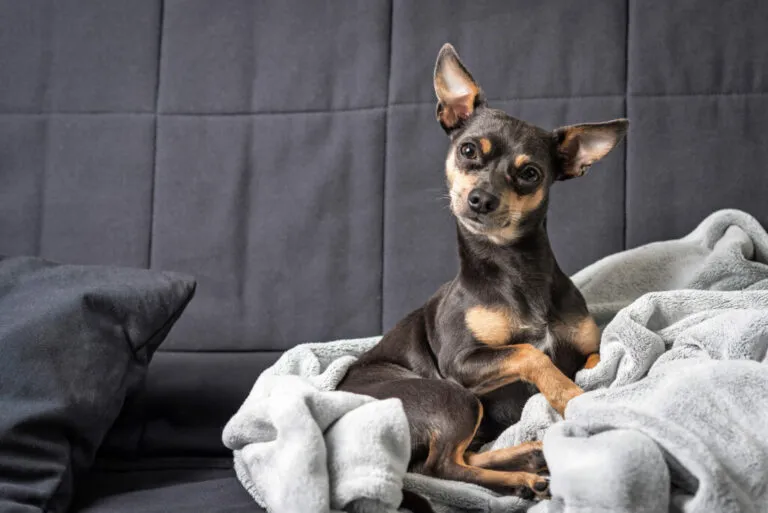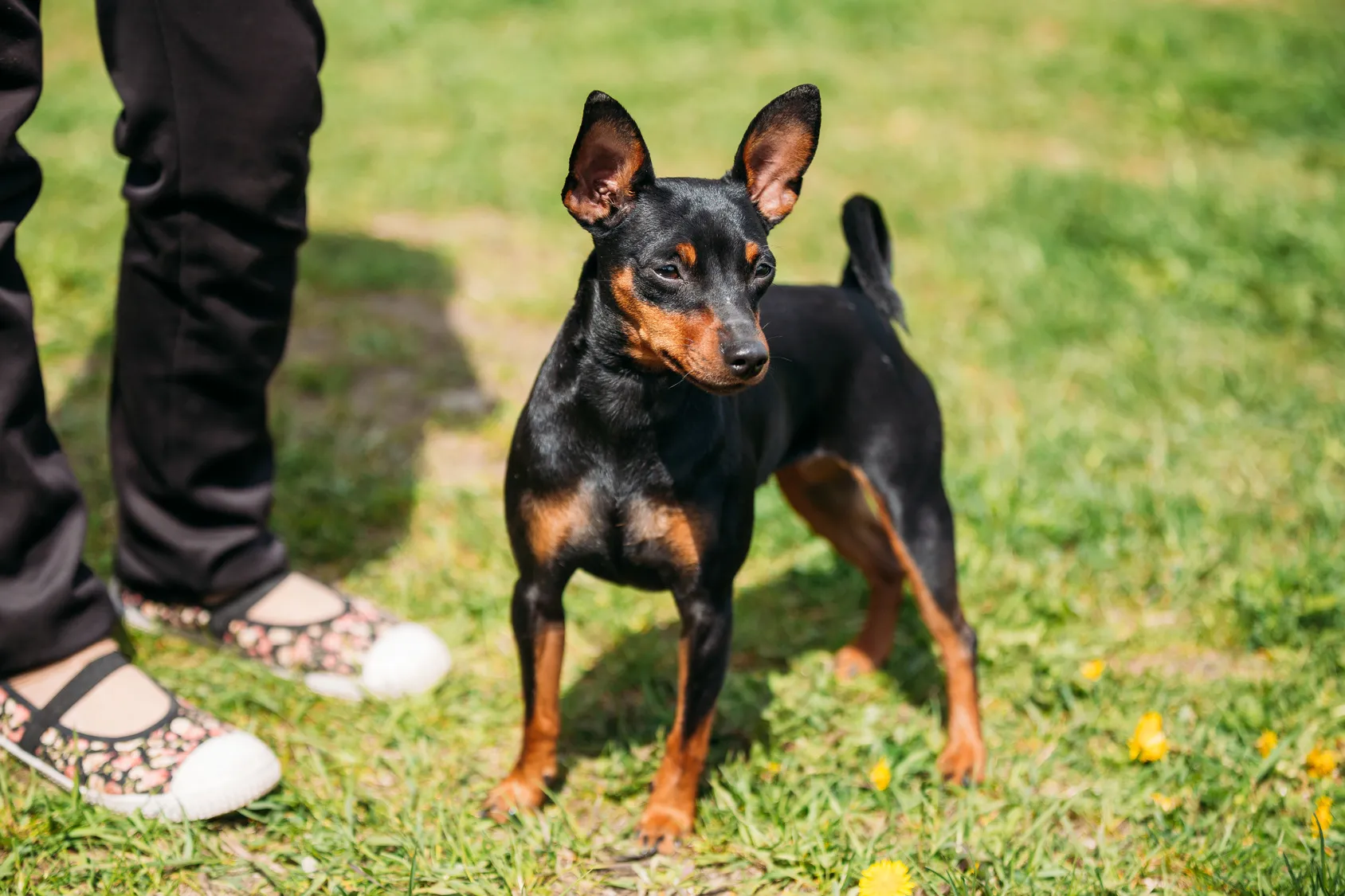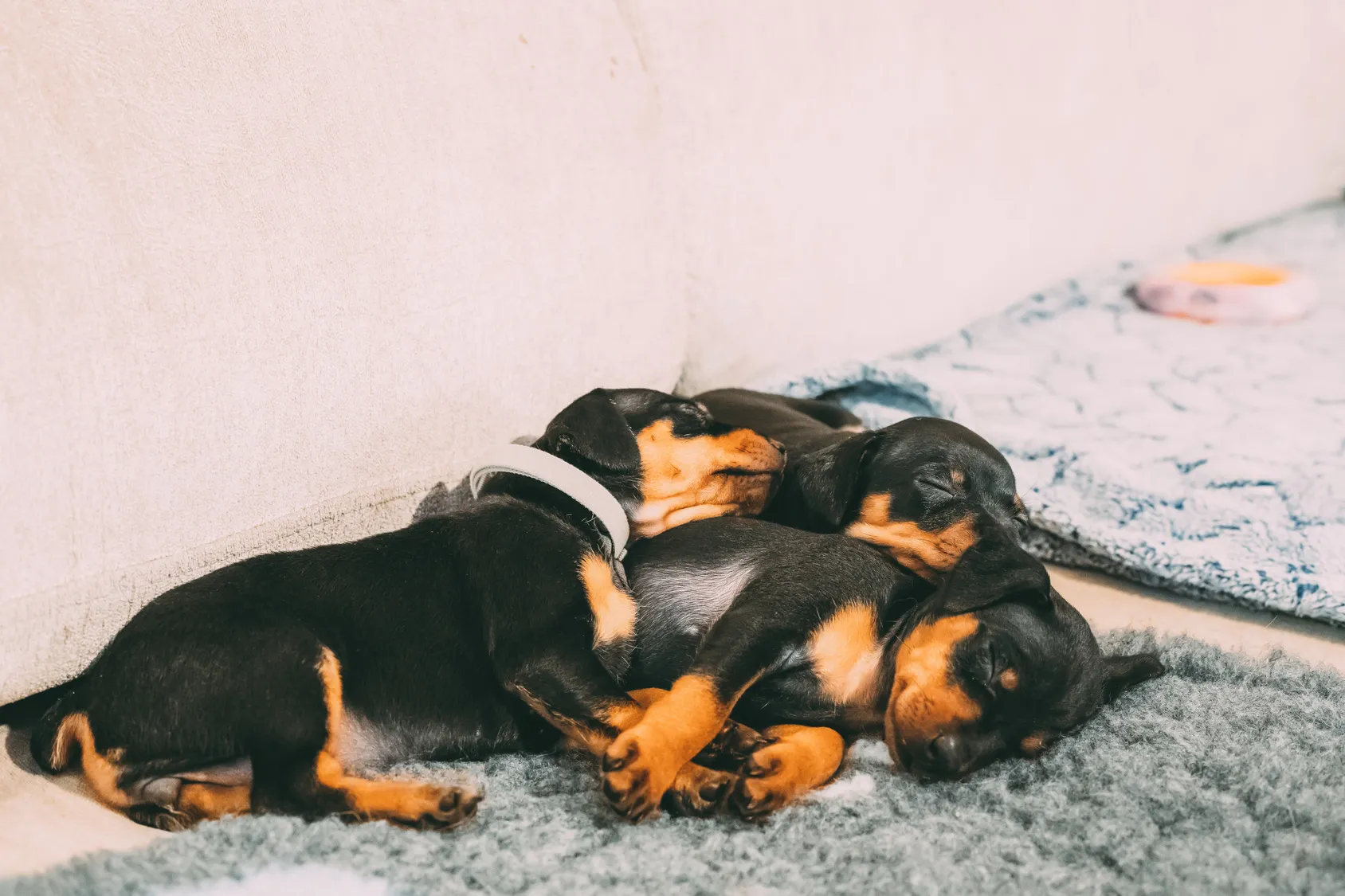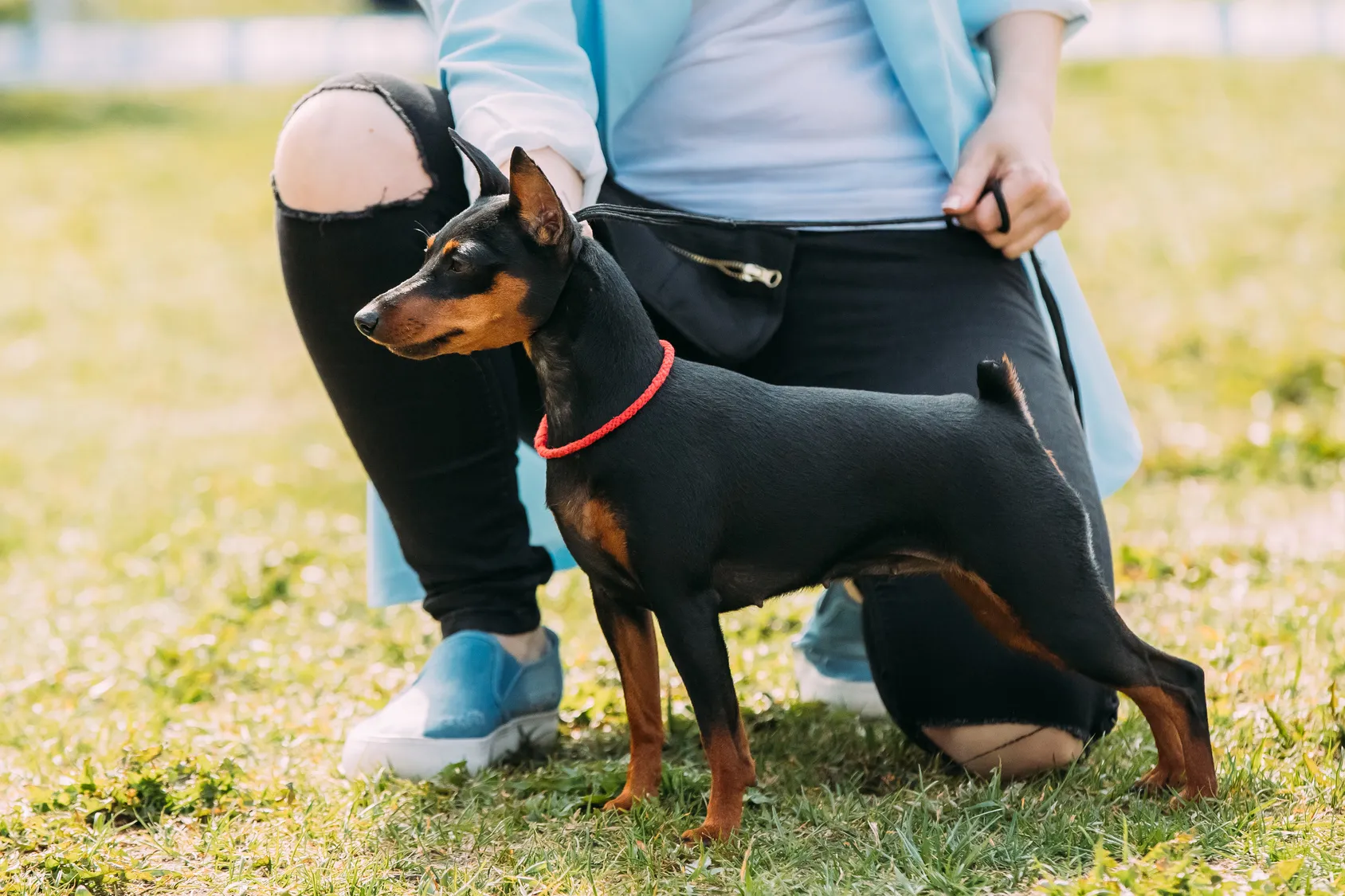Beagle
The Beagle's short legs can be deceiving – this medium-sized dog keeps you on your toes and is always full of surprises! This friendly breed is active, fearless and extremely clever.
An adorable, pocket-sized version of a Pinscher? Do not be fooled! If you are looking for a cute, cuddly little lapdog, then you have come to the wrong place. In spite of its size, this bright family dog has a huge appetite for sport and movement, and will run its owners off their feet in so many ways!

© Piotr Wawrzyniuk / stock.adobe.com
Visually, the Miniature Pinscher is simply the mini-me of the German Pinscher. At just 25-30 cm from shoulders to floor, it is around 20cm small than its larger relative and around 10kg lighter, weighing in at just 4-6kg.
Just like the German Pinscher, its build is quadratic, meaning that its height and length are approximately equal. The Miniature Pinscher has an extremely muscular and elegant body, which is really accentuated during movement thanks to the short, smooth coat. Its head is strong and elongated into an oblong shape, with a flat, smooth forehead. The V-shaped ears sit high on the head and can be either pricked or dropped to the front. The fold of the dropped ear should be below or at the same level as the top of the head. This is decided naturally, although the aim of the breed is for it to be in a sabre- or sickle-shape.
The tight, smooth skin is covered in short, thick hair with no bald spots. The smooth hair structure gives the coat a brilliant shine, which can be in black and red or plain brown. The fur of the black and red variety tends to be a glossy black, with rust red or brown markings. These marks can be dark and sharply outlined, appearing above the eyes, on the underside of the throat, on the pasterns, on the feet, at the inside of the hind legs and under the root of the tail. It is also characteristic for the Miniature Pinscher to have two uniform triangles on the front of its chest. The single-colour variety has a brown tone to its fur, ranging from deer red to reddish-brown to dark red brown. It is often known as the “Deer Pinscher” due to this reddish colour.
 © Grigory Bruev / stock.adobe.com
© Grigory Bruev / stock.adobe.com
This breed is known in the English-speaking world as the Miniature Pinscher or Mini Pinscher and is related to the German Pinscher. Unlike other small breeds of dog, however, the small size of this breed does not bring with it any health disadvantages. Its body oozes strength and, watching it move, you can see just how fast, robust and athletic this little guy really is. Miniature Pinschers are great for any athletic situation, whether it is horse riding, walking, mountain climbing, cycling or jogging – this small, agile and speedy dog will get enthusiastic for every sporting activity its humans get involved with. The main thing is, it will be right there with you!
This devoted dog does not particularly enjoy being left on its own, particularly not for long periods of time – you have been warned! Miniature Pinschers are fixated on their owners and will happily follow them wherever they may go. They truly show off the old phrase, “a dog is a man’s best friend”! All of their love gets directed at a single person. That is not to say that your Miniature Pinscher will not get very attached to other family members as well, happily obeying them and going for walks with them, but it will not truly feel complete until its closest confidante is right there by its side. In 1905, Richard Strebel wrote about Miniature Pinschers in his book, “German Dogs”, one of which he owned at the turn of the century. He wrote, “His character is admirable, in the entire house he recognises only my wife, in spite of our pampering him, trying everything to change his allegiance, all attempts fail due to his incorruptibility!”
Although the Miniature Pinscher is often considered to be an even-tempered, playful dog that is always in a good mood, the natural guarding instinct of its ancestors is also clear in this dog’s belief that it is its own responsibility to protect its owners’ house and belongings from intruders and pests. Miniature Pinschers are particularly likely to have a low tolerance level when the situation involves the wellbeing of its so dearly loved owner. However, by socialising your dog well when it is a puppy and applying consistent training, you can help reduce aggressive barking. Miniature Pinschers have a natural affinity for learning and are quick to grasp new concepts during training. A good dose of curiosity and the chance to develop freely within a set framework should combine to make your dog naturally attentive. The Miniature Pinscher needs significantly more exercise than other dog breeds of its size in order to meet physical as well as mental demands. If this need is taken into account, for example by getting your dog involved with training and competitions, you can help ensure that the Miniature Pinscher, often prone to nervousness, becomes a pleasant and well-balanced family dog. This breed can also live peacefully with other pets, including cats or birds. That being said, your lively dog’s natural hunting instinct is still bound to be awakened by a mouse or cat running freely across its path!
When you consider the history of the Miniature Pinscher, this natural guarding and hunting instinct is really not all that surprising. Dogs under the Pinscher breed umbrella are descended from Peat Dogs, which were the companions of men many thousands of years ago. Skull and bone findings show that this archetypal dog guarded Stone Age settlements, helping to keep rodents and other plague spirits at bay. By the end of the 19th century, Pinschers could be found at almost every farm. These dogs were known as “Rattlers” and were popular with farmers due to their vigilance and skill at hunting rats and mice. Even masters of survival such as rats will struggle to evade the swift and wily clutches of the Pinscher!
The rough-haired Schnauzer was once thought to be of the same breed as the smooth-haired Pinscher, a fact verified by the “Pinscher-Schnauzer Club”, originally set up in 1895 and still in existence today. The club founder Josef Berta first began distinguishing the two as separate breeds in the beginning of the 20th century. The pedigree Miniature Pinscher breed appeared relatively early on in this scenario, breaking quickly away from its larger breed cousins. Unlike the German Pinscher, the Miniature Pinscher rapidly became a popular housedog. By the turn of the century, there were already a large number of these dogs being kept in private households. In 1925, the studbook of the Pinscher-Schnauzer club already contained some 1300 entries. It was high society women in particular that showed a fondness for decorating themselves with these small, elegant dogs. In 1937, Felix Ebener described these fashionable dogs with the following words: “He needs little space and little care, can be very well-behaved and genteel and is charming and delightful even when playfully misbehaving. With his clean paws and his short, smooth fur, he can be safely left on even the most elegant upholstered furniture […].”
As one of its very first breeders, Josef Berta recognised that this image of the Miniature Pinscher as simply a lapdog was not in the slightest bit correct. Berta was in fact so impressed by his own Miniature Pinscher, Max v. Klein-Paris, that he reported: “I have had many well-behaved dogs, some of which have left unforgettable memories in my home. Max surpasses them all – he is the best, most understanding, most pleasant and most useful housemate that I have ever had!” Singing his dog’s praises in this way encouraged other breeders to take on the Miniature Pinscher. It was Berta and his colleagues who ultimately made the Miniature Pinscher what it is today: a distinctive dog with good character, spirited temperament, robust health and proud beauty.
 © Grigory Bruev / stock.adobe.com
© Grigory Bruev / stock.adobe.com
Ernst Kniß-Leipzig has to be one of the most well-known breeders of this healthy, elegant breed. He founded the “vom Klein Paris” line of Miniature Pinschers and his dogs Champion Wichtel, Ulrich, Dirndl, Heinerle and Gretel von Klein-Paris have contributed greatly to the realisation of this breed.
As a reputable breed, the Pinscher-Schnauzer Club prescribes certain breed and health standards in Miniature Pinschers. The healthy development of these dogs should always be of the utmost importance. Miniature Pinschers are different from all other breeds, not suffering from illnesses normally found in small breeds. In contrast, they are seen as very active, healthy dogs. In this respect, they have nothing in common with the Chihuahua or the Prague Ratter, which have been bred to be excessively small and delicate and can, therefore, be extremely prone to illness. These small dogs, which can weight just 2kg and come primarily from mass breeding, are not a dog breed recognised by the FCI in Germany.
The main similarity between Miniature Pinschers and Chihuahuas is their sensitivity to the cold. The thin ears are particularly susceptible to frostbite and when the weather is extremely cold, it is recommended that the Miniature Pinscher wear a dog coat.
When choosing a suitable Miniature Pinscher breeder, it is important to check that the dogs are being bred according to the prescribed breed standards given by the FCI. You should be able to visit the house to check the integrity of the breeder, as well as to get to know the puppies or at least the mother in an environment that is familiar to it. In the course of such a visit, the breeder will give detailed information about the characteristics of his particular line of the breed, as well as offering useful tips about training and nutrition. In turn, he will naturally want to know about your own living situation, so that he can be sure his Miniature Pinscher puppies are going to be in safe hands. A serious breeder will be more concerned about sending his litter to a good home than about getting rid of them as quickly as possible.
 © Grigory Bruev / stock.adobe.com
© Grigory Bruev / stock.adobe.com
If you have decided to go ahead with the purchase of a Miniature Pinscher, you should be aware that, although it is a small dog, it needs no less attention and exercise than a larger breed dog. Miniature Pinschers are very affectionate animals, requiring plenty of contact and attention from their owners. If you have a full-time job that means you will need to leave your dog alone for long periods of time, then this is not the breed for you. The most suitable owners are sporty people that can spend plenty of time with their dog and love to get out and about moving around with their four-legged friend. In spite of their size, Miniature Pinschers make great companions for any number of leisure activities, including horse riding, hiking, mountain climbing, jogging and cycling. This fast and agile breed will also be in its element taking part in dog sports such as agility training. However, dog owners will benefit from not only keeping this dog involved in team sports, but also from introducing a consistent training regime.
Enrolling your Miniature Pinscher in dog school can help it learn to control its sometimes-short temper, as well as teaching it to react calmly despite its natural urges. Ideally, you should begin socialising your dog from when it is a puppy, to help get it used to other dogs. As these puppies require near constant attention and lots of care, they are unsuitable for families with children under three years of age, as they demand equal amounts of love and fuss!
It is essential for your Miniature Pinscher’s training and social skills that it takes part in some kind of sport or activity, as it will help to tire it out so that it can be calm and relaxed at home. Miniature Pinschers are small enough to even be comfortable living in an apartment, as long as they receive sufficient physical and mental stimulation. Aside from extensive exercise and training, caring for your Miniature Pinscher is fairly straightforward. The short coat only needs grooming on occasion, while dirt can simply be wiped off the fur with a damp cloth!
All in all, it is important that Miniature Pinschers have owners that are aware of their spirited temperament, but who have the time to devote themselves to this dog – body, mind and soul! To show their gratitude for this loving treatment, Miniature Pinschers can bring life and happiness to any household. You can welcome into your life a faithful friend, who is always ready to play and will literally never leave your side!
The Beagle's short legs can be deceiving – this medium-sized dog keeps you on your toes and is always full of surprises! This friendly breed is active, fearless and extremely clever.
The Golden Retriever is still one of the most popular dog breeds, especially with families. It is defined not just by its docility, but shows numerous other qualities too. Read in the following article everything you need to know about the Golden Retriever.
The German Shepherd is one of the most popular utility dog breeds in the world, though the willing-to-learn and people-focused nature of these versatile dogs also makes them suitable for family life.